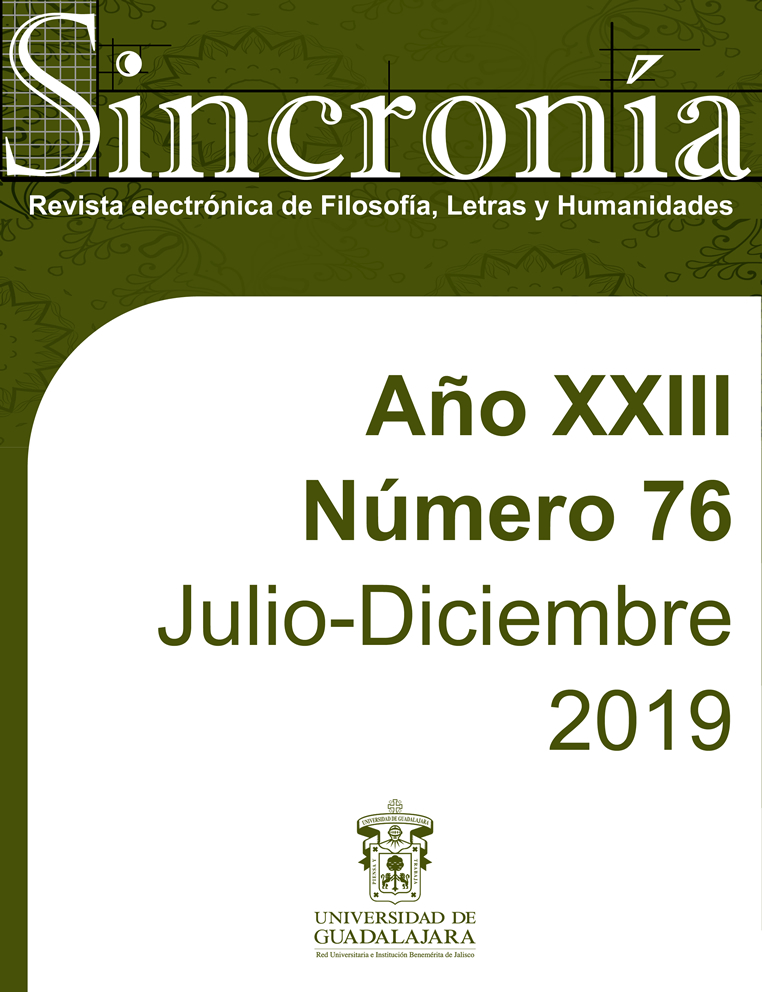In the desert everyone is Apache: the identity of the North in Tomóchic, by Heriberto Frías
Keywords:
Nineteenth-century Mexican novel, Regional memory, National mapAbstract
Tomóchic (1893), by Heriberto Frías, forms part of the cultural discourses of the 19th century that helped to build the map of Mexico into the social imaginary. In particular, the work of Frías is inserted in the tradition of representations of northern Mexico, where names such as Manuel Payno, Ignacio Ramírez the Necromancer and Guillermo Prieto appear. Unlike these, however, Heriberto Frías is a particular case because, although it ratifies some of the premises of the ciudad letrada on the national map, it offers small strokes on the northern territories that dialogue conflictively with the "canonical" imaginary of the northern regions. Therefore, some parts of Tomóchic are built on the tension produced by the contact of two opposing images. On the one hand, we find interspersed in the plot the features that a centralist-nationalist look typical of the late eighteenth-century liberal would attribute to the northern subject and space; however, on the other, the social commitment of Heriberto Frías leads him to approach the subject of the north in order to humanize it, and despite the cultural and epistemological obstacles, traces, though timidly, a northern identity.
Downloads
References
Almada, I.; Lorta, J. C.; Contreras, D. y Reyes A. A. (2015). “Casos de despueble de asentamientos atribuidos a apaches en Sonora. Un acercamiento a los efectos de las incursiones apaches en la población de vecinos”. En Medina, J. C. y Calderón, E. P. (Coords.), Violencia interétnica en la frontera norte novohispana y mexicana. Siglos XVII-XIX. Hermosillo, Sonora: El Colegio de Sonora.
Alonso, A. M. (1995). Thread of Blood: Colonialism, Revolution, and Gender on Mexico’s Northern Frontier. Tuczon, Arizona: University of Arizona Press.
Barabas, A. M. (2000). “La construcción del indio como bárbaro: de la etnografía al indigenismo.” Alteridades, 10(19), 9-20.
Bartra, R. (1992). El salvaje en el espejo. México: ERA.
Cramaussel, C. (2015). “La violencia en el estado de Chihuahua a mediados del siglo XIX. Apaches y comanches”. En Medina, J. C. y Calderón, E. P. (Coords.), Violencia interétnica en la frontera norte novohispana y mexicana. Siglos XVII-XIX. Hermosillo, Sonora: El Colegio de Sonora.
Chávez, D. (2006) “Tomóchic: nationalist narrative, homogenizig late nineteenth-century discourse and society in Mexico”. Chasqui: Revista de Literatura Latinoamericana, 35(2), 72-88.
Chávez, J. (2007). “De gente ruda a gente sencilla. Símbolo del hombre norteño.” En Pérez-Taylor, R.; Olmos, M. y Salas, H. (Eds.), Antropología del desierto: paisaje, naturaleza y sociedad. México: Universidad Nacional Autónoma de México.
Davobe, J. P. (2004). “Tomóchic de Heriberto Frías: violencia campesina, melancolía y genealogía fratricida de las naciones”. Revista de Crítica Literaria Latinoamericana, (60), 351-373.
Florescano, E. (2010). Memoria mexicana. Ciudad de México: Fondo de Cultura Económica.
Giménez, G. y Héau-Lambert, C. (2007). “El desierto como territorio, paisaje y referente de identidad.” Culturales, 3(5), 7-42.
González, C. y León, R. (2000). Civilizar o exterminar. Tarahumaras y apaches en Chihuahua, siglo XIX. Ciudad de México: Instituto Nacional Indigenista.
Gupta, A. y Ferguson, J. (2008). “Más allá de la ‘cultura’: espacio, identidad y las políticas de la diferencia”. Antípoda. Revista de Antropología y Arqueología, (7), 233-256.
Hall, E. (1989). Inventing the Barbarian: Greek Self-Definition through Tragedy. Oxford: Oxford University Press.
Jordán, F. (1981). Crónica de un país bárbaro. Chihuahua, Chihuahua: Centro Librero La Prensa.
Legrás, H. (2017). Culture and Revolution: Violence, Memory, and the Making of Moderno Mexico. Texas: University of Texas Press.
López, J. (2013). “Monstruosidad y salvajismo: trazas míticas en el marco de la racionalidad griega antigua.” Praesentia, (14), 1-21.
Moyano, M. (2001-2002). “La fundación ideológica de las literaturas nacionales. Literatura y territorialización en el siglo XIX argentino”. Cuyo Anuario de Filosofía Argentina y Americana, 18(19), 51-61.
Muñoz, O. M. (2008). “Salvajes, bárbaros y brutos: de la Grecia clásica al México Contemporáneo”. Liminar: estudios sociales y humanísticos, 6(2), 155-167. Nentvig, J. (1971). Descripción geográfica, natural y curiosa de la provincia de Sonora. (Original manuscrito del siglo XVIII). (Ed. Germán Viveros Maldonado). México: Archivo General de la Nación.
Orizaga, D. (2008). “Mediación autorial en Tomóchic, de Heriberto Frías”. Graffylia. Revista de la Facultad de Filosofía y Letras, (6), 197-204.
Rajchenberg, E. y Héau-Lambert, C. (2012). “El desierto como representación del territorio septentrional de México.” Antítesis, 5(9), 351-369.
Rajchenberg, E. y Héau-Lambert, C. (2007). “La frontera en la comunidad imaginada del siglo XIX.” Frontera Norte, 19(38), 37-61
Rajchenberg, E. y Héau-Lambert, C. (2005). “Las fronteras de la patria.” Estudios Sociológicos, 33(67), 239-252.
Rajchenberg, E. y Héau-Lambert, C. (2008). “Para una sociología histórica de los espacios periféricos de la nación en América Latina”. Antípoda. Revista de Antropología y Arqueología, (7), 175-196. Raffi-Béroud, C. M. H. (2001). “Heriberto Frías o el escritor en la encrucijada: ¿avenida de la novela o bulevar de la prensa”. En Olea, R. (Ed.), Literatura mexicana del otro fin de siglo. México: El Colegio de México.
Sandoval, A. (2001). “Tomóchic de Heriberto Frías a la luz de la Débacle de Émile Zola”. En Olea, R. (Ed.), Literatura mexicana del otro fin de siglo. México: El Colegio de México.
Downloads
Published
How to Cite
Issue
Section
License
Copyright (c) 2019 Daniel Avechuco Cabrera

This work is licensed under a Creative Commons Attribution-NonCommercial 4.0 International License.
You are free to:
- Share — copy and redistribute the material in any medium or format
- Adapt — remix, transform, and build upon the material
- The licensor cannot revoke these freedoms as long as you follow the license terms.
Under the following terms:
- Attribution — You must give appropriate credit , provide a link to the license, and indicate if changes were made . You may do so in any reasonable manner, but not in any way that suggests the licensor endorses you or your use.
- NonCommercial — You may not use the material for commercial purposes .
- No additional restrictions — You may not apply legal terms or technological measures that legally restrict others from doing anything the license permits.



























